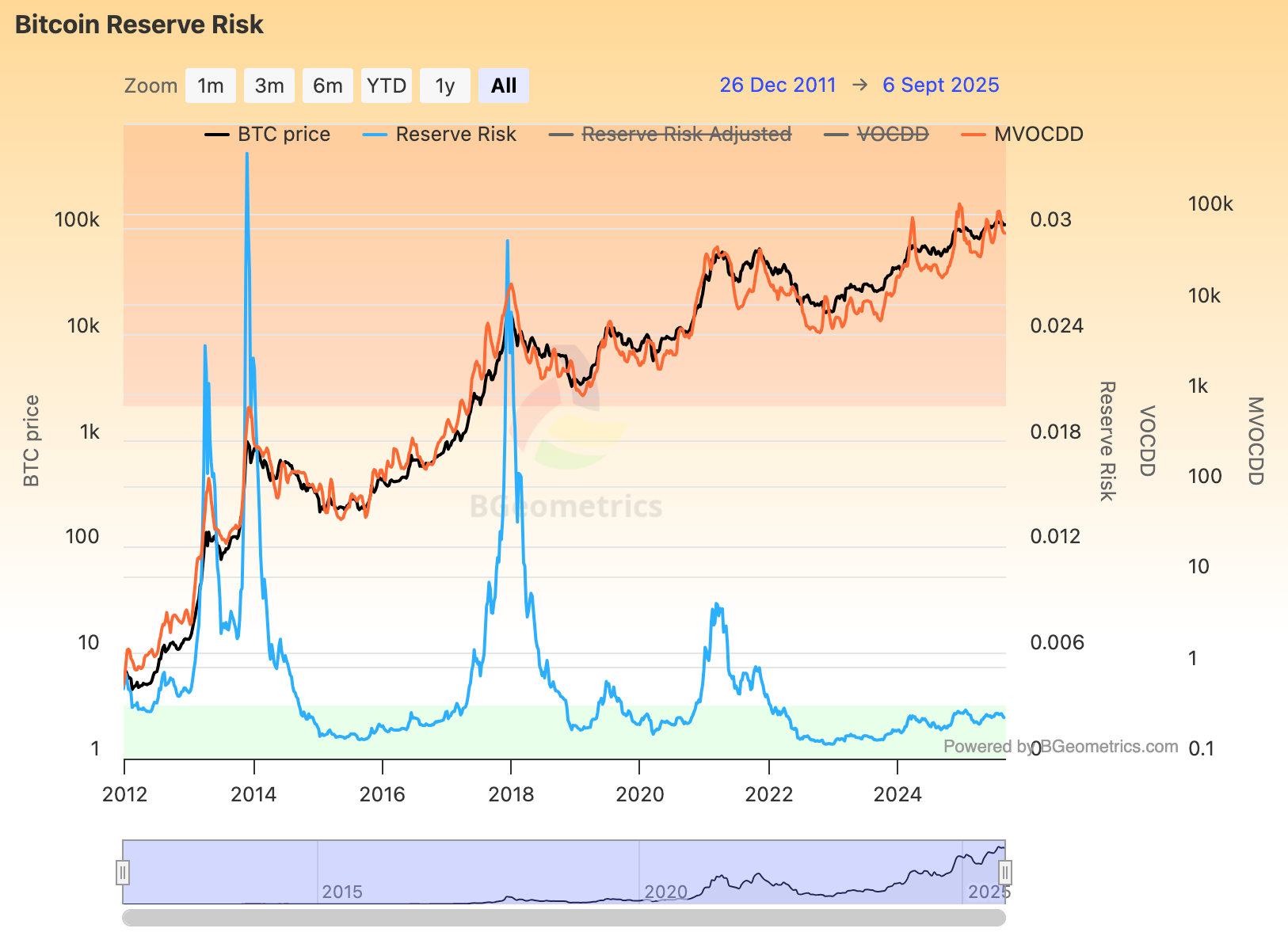What Are Reserve Risk and HODL Bank?
Reserve Risk gauges the balance between price and the confidence of long-term holders. It is defined as the current Bitcoin price divided by HODL Bank.
HODL Bank is a running measure of the opportunity cost of holding that builds when holders sit tight and falls when older coins are spent in size. When coin-day destruction is low, HODL Bank tends to rise. When old coins move at higher prices, HODL Bank tends to decline.

This chart places price in context with long-term holder confidence and highlights historically favourable and risky zones.
How Reserve Risk Behaves
- Rising price pushes Reserve Risk higher.
- Rising HODL Bank pushes Reserve Risk lower by adding weight to the denominator.
- Sideways price while HODL Bank climbs can pull Reserve Risk down into favourable territory.
- Elevated price and falling HODL Bank can push Reserve Risk into riskier territory.
Why It Matters
- It frames risk versus reward through a holder-confidence lens rather than only price.
- It helps separate late-bear accumulation windows from late-cycle risk.
- It captures the effect of halvings and changing miner issuance indirectly through holder behaviour.
Interpreting Zones
Treat zones as guides. Use historical percentiles rather than fixed numbers.
- Depressed Reserve Risk often aligns with late-bear to early-bull phases where patient capital dominates.
- Mid-range Reserve Risk is compatible with constructive advances if other indicators agree.
- Elevated Reserve Risk has coincided with late-cycle conditions where distribution risk rises.
Practical Reads

- Duration matters more than single prints. Sustained time in favourable zones carries more information than a quick dip.
- Look for falling Reserve Risk during consolidations. That often reflects growing holder confidence beneath price.
- Be cautious when Reserve Risk rises quickly while other behaviour metrics show distribution.
Use With Confluence
Pair Reserve Risk with:
- Liveliness or CDD to confirm whether old coins are actually moving.
- SOPR and Realised Profit/Loss to see if profit taking is being absorbed or not.
- Realised Price bands to check if price has firm cost-basis support when Reserve Risk is low.
- Exchange netflows to validate whether supply pressure is increasing.
Common Pitfalls
- Treating any single zone as a trigger without support from behaviour and flow data.
- Ignoring that bands migrate as liquidity and market participation evolve.
- Reading Reserve Risk without checking whether HODL Bank is rising or falling.
A Simple Workflow You Can Reuse
- Open Reserve Risk (weekly) and note the zone and direction.
- Check Liveliness or CDD to see whether old coins are moving.
- Cross-check aSOPR and Realised PnL for behaviour.
- Compare price with Market, LTH, and STH Realised Price for valuation support.
- Decide: improving confidence with support, or elevated risk with signs of distribution.
FAQ

Is low Reserve Risk automatically bullish?
Not by itself. It improves the risk-reward backdrop, then you look for confluence in behaviour and valuation layers.
Why can Reserve Risk stay low for months?
If HODL Bank keeps rising while price is range-bound, confidence builds and the denominator stays heavy.
Does a spike mean a top?
Spikes need confirmation. Combine with SOPR, Realised PnL, and exchange flow before acting.
If this tightened your read on holder confidence versus price, join Alpha Insider for Reserve Risk regimes, HODL Bank studies, and weekly timing windows. Fewer mistakes, cleaner execution, more conviction.
The Markets Unplugged members get:
➡️ Kairos timing windows to plan entries before the crowd moves
➡️ A full DCA Targets page with levels mapped for this cycle
➡️ Exclusive member videos breaking down charts in plain English
➡️ A private Telegram community where conviction is shared daily
➡️ A dedicated Bitcoin On-Chain Analysis page with regularly updated analysis and monthly reports (MVRV, SOPR, NUPL, Puell, URPD)
It’s the full playbook.















Discussion